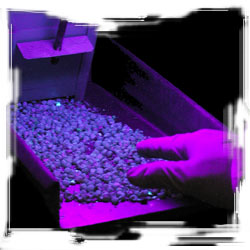February, 2005
 A CIMMYT research team is using an old but effective technique to get a head start on some very advanced crop science. Their aim is to breed high yielding maize that also resists infection by a dangerous fungus. As part of a USAID-funded project, the team uses ultraviolet or black light to identify maize that inhibits Aspergillus flavus, a fungus that produces potent toxins known as aflatoxins.
A CIMMYT research team is using an old but effective technique to get a head start on some very advanced crop science. Their aim is to breed high yielding maize that also resists infection by a dangerous fungus. As part of a USAID-funded project, the team uses ultraviolet or black light to identify maize that inhibits Aspergillus flavus, a fungus that produces potent toxins known as aflatoxins.
The fungus is particularly widespread in maize-growing regions of Africa, and the aflatoxins it produces can cause health problems in those who ingest it in high doses. By starting with elite maize varieties, those that already cope well in drought and high temperatures, and that resist damaging insects, the project hopes to produce a “package deal” for farmers: maize lines can survive these conditions and resist Aspergillus flavus.
No continent is immune from the Aspergillus problem. During 1988-1998, losses from aflatoxin damage in the US exceeded USD 1 billion. The United States has set an upper permissible aflatoxin level of 20 parts per billion in food, and the European Union has even stricter tolerances. A carcinogen, aflatoxin was recently linked with the deaths of more than 50 people who consumed contaminated grain in Kenya. A study in West Africa found a strong association between aflatoxin levels in children’s blood and stunted growth. “There is no easy quick-fix to this problem,” says Dan Jeffers, CIMMYT researcher overseeing the project, “but when a solution is found, everyone wins.”
By collaborating with scientists in the US, CIMMYT is better able to accomplish its goal of helping resource-poor farming households who consume their own maize. “We want to combine useful traits that will lessen the incidence of aflatoxin in the crop,” says Jeffers. “By crossing maize varieties that already are drought tolerant with those that resist Aspergillus, commercially viable and attractive lines should emerge.” This holistic approach will provide better varieties to collaborators and eventually to farmers.
The kernels vibrate as they shuffle down the tray of the light box. Healthy kernels appear faded under the black light, but the infected grain glows. Jeffers and his team will use the fluorescence data to choose the maize lines that show the least amount of fungal infection. “The most promising materials will then be used in further studies to look at aflatoxin levels,” Jeffers says.
 Climate adaptation and mitigation
Climate adaptation and mitigation